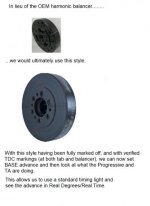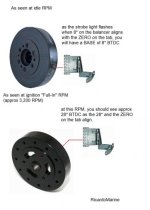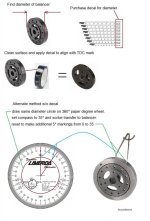RicardoMarine
Gold Medal Contributor

Perhaps so, but have you looked to see if it's offering the correct progressive advance?
If not, the return springs may be compromised causing the BASE advance to be erratic.
but i replaced the dizzy with another unit, so wouldn't that issue be irrelevant?
My thoughts:
You have an issue that has been difficult to resolve.
Many suggestions have been made.
Nothing has offered resolve thus far.
The P of E is going to help you, and will hopefully give resolve.
In order to perform the P of E systematically and methodically, you will want to make a list of suspect areas and/or components.
You will want to stick to the list.
As you go down the list, you will want to verify the function of each suspect area and/or component, checking/testing/replacing one item ONLY at a time.
In my opinion, the ignition distributor (even though you have this spare) should be on this list.
In order to verify (i.e., eliminate the distributor from the suspect list), you will want to have it tested by a Pro using a distributor machine.
The suggested degrees markings on the balancer would help you do an "on-engine" test (testing it yourself), however, with the other unknown potential issues, I would not suggest this............ at least not at this time!
FYI:
Spark advance is seen in crankshaft degrees.
BASE advance will be seen as 6* or 8* and is always prior to any centrifugal action (advance).
As the engine speed increases, so does the spark advance until the spark advance reaches what we call the "Full-In" RPM.
The distributor's mechanical advancing system will offer approx 11* of centrifugal movement (flyweight/cam advance) at the distributor only.
Since the distributor shaft rotates only once per every two crankshaft revolutions, the 11* will be multiplied Xs 2
That equals approx 22* of mechanical advance that will be seen at the crankshaft.
Now add a BASE advance of 6* or 8*, and you end up with approx 28* or 30* total (at the crankshaft) when the advancing system is Full-In!
In other words, you will/should be able to move the rotor approx 11* and then see it return CCW.
Question:
If you have this distributor in hand, and if you firmly hold and prevent the driven gear from spinning (within the housing), are you able to move the rotor CW and then see it return?
If so, does it appear to move approx 11* and back?
However, this check does not indicate that the centrifugal system is offering the correct advance curve....... hence the Sun, Allen or King distributor machine testing.
It's your call...... I'm just trying to help you resolve this issue as thoroughly and as quickly as possible.
If you systematically and methodically use the P of E, you will eventually find what is wrong with this engine.
Otherwise, I think that you'll keep spinning your wheels!
.
Last edited:




